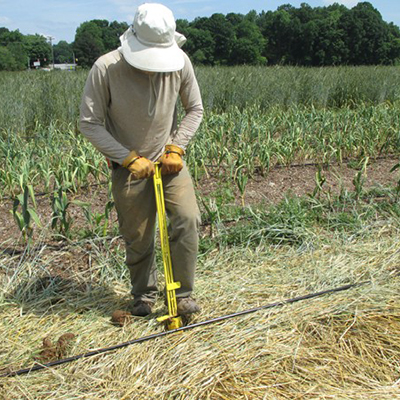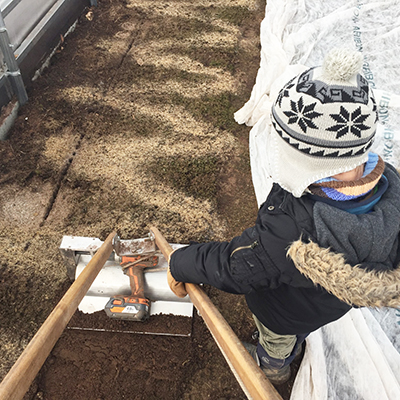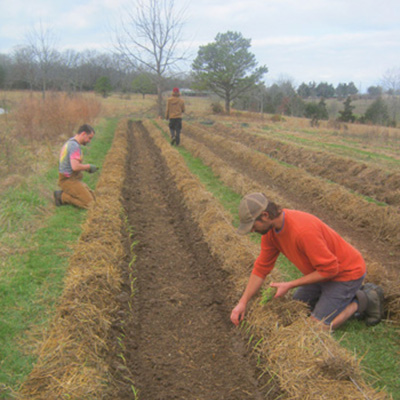Sycamore Bend Farm is located in the Ozark hills of northwest Arkansas, near Eureka Springs. One acre of permanent vegetable beds, berries, a greenhouse, and a high tunnel are situated on creek bottomland, giving us a couple feet of silty loam with variations of gravel and clay to work with.
My wife Madeleine and I manage the farm and our two young children. We keep a small flock of registered Katahdin sheep on the surrounding acres. The farm provides two full time jobs to us, plus additional hired help during the primary harvest season of May through November. The farm grosses about $80,000 a year from the veggies and berries.
I dedicate about a third of our growing area to sweet potatoes each summer. Ozark Natural Foods- an organic co-op in nearby Fayetteville- buys most of the sweet potatoes, along with the majority of our other produce. We also sell at two farmers markets in Eureka Springs, and a few area restaurants.
In the fall on the author’s farm, sweet potatoes grow to the left of the tree and mixed vegetable crops are to the right. All images courtesy of Andrew Schwerin.

Sweet potatoes are not a big moneymaker for the amount of garden space they use, compared to more intensive crops like lettuce, tomatoes, and basil. However, they have some important advantages on our farm:
- Produce well in our soil
- Aren’t troubled by intense summer heat
- Extensive vines will smother most weeds
- Few pest or disease issues
- Most labor is in early October, between intensive harvests of summer and fall crops
- Store long-term for steady sales through the winter
Planning
Our farm maintains permanent beds, mainly hand-worked, at a little less than 4’ wide. We use rabbit manure as the primary fertilizer as well as compost, and use straw mulch for the purpose of adding organic matter, creating a healthy soil environment, and weed suppression. With seventeen 150’ beds and twenty 100’ beds, I rotate 1500 bed feet of sweet potatoes through a third of the garden each season. I plant straight down the middle of each bed, giving almost 6’ between each row. The sweet potato vines could make use of the sunlight between rows 8’ apart.
I plant in early June, about 3-5 weeks after the last hard frost. By that point the soil has lost its spring chill, the days are getting hot, and the nights will generally be above 55 degrees. We fertilize our garden in the early winter, primarily using a five gallon bucket of rabbit manure for five linear bed feet, and put everything to “sleep” under a layer of straw mulch for the winter. For the upcoming sweet potato area, I use about half the regular manure, a regular amount of compost, and light straw mulch. During the summer the vines will become a canopy of living mulch, and too much straw gets in the way of the harvest.
The early summer planting allows the area to be used for the first round of spring greens- lettuce, spinach, etc. We clear straw away for those crops, grow, and harvest by mid to late May. Carpetweed soon becomes the dominant weed and then we know it’s about time to plant sweet potatoes. We hoe the weeds and/or move a 30’ by 100’ sheet of black plastic to kill the weeds a couple weeks prior to planting.
Propagation
I’ve had successful crops using the basic propagation technique of storing a box of sweet potatoes over the winter, planting the roots in potting mix in April, and keeping them moist in the greenhouse. I would break slips off when they got six inches long, and plant them in the field.
After reading “A new way to propagate sweet potatoes” in the March 2015 issue of Growing for Market, I concentrated on single node cuttings in 2016, using my saved second generation Beauregards in the greenhouse. I moved my tubers to this warm, moist area in mid to late April. By the middle of May I was cutting a couple hundred nodes twice a week. After planting a node in a seedling tray, it would take some time for it to develop both a root and send out new leaves. In the same time, the remaining vines in the greenhouse bed would send out a new vigorous shoot at each of the many nodes still remaining. I made use of this habit- I started cutting the vine ends- and the plant would respond by sending out even more shoots, giving me exponentially more “tips” each week.
The tips would develop two or three small leaves by the time I cut them off with five nodes. I took the lower leaves off these cuttings, counted out bundles of a hundred, and packed the whole bundle with some potting mix in a quart size pot. I would wet the soil, and keep the pot dark under a greenhouse bench for a couple days. The roots seem to develop in response to darkness with some moisture. Using our planting method described below, I wanted to plant the cuttings before the roots grew too long, or they would break off when slid into the hole. This would give me a five-node cutting, with three nodes developing roots, and the tip vigorously extending the vine growth.
Some of my single node cuttings got “stuck” without developing new leaves - both in the trays and in the field. Of the first beds planted, a portion didn’t thrive. I quickly changed to a “two-node” cutting- one node for the root and one node for leaf growth. By the end of planting a couple weeks later, I had moved to the five-node method described above.
The photo below shows where to cut to get a five-node slip from a potted sweet potato. The author aims to put three nodes below the soil line to develop into roots. Spreading tuber set over multiple nodes will result in more moderately sized tubers.
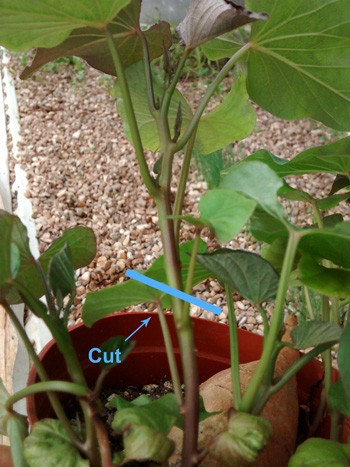
At harvest in late September, I was getting a couple hundred pounds from the single-node beds. The two-node beds were up in the 500-pound range, but due to having a single root mass, I only got one or two sweet potatoes from each plant – and each tuber weighed about six pounds! We already have a problem with an excess of jumbos on our farm, so that was not the way for us to go. Having 3+ nodes developing under the soil gave us fewer monster-size potatoes.
Since I’ve had problems with scurf from other sources, now I only buy micropropagated, virus-indexed slips by the thousand from Jones Family Farms. They’ve stopped growing my beloved Beauregard, so this year I’ll try New Orleans for the second time. I have one Beauregard potted in the greenhouse, just to keep the variety going.
The golden grail of sweet potato production is 1,000 pounds per 100 bed feet. We’ve achieved it a few times, but the occasional poor planting giving 250 pounds in a bed averages out the harvest to 500-600 lbs/100’ bed. We plant slips about twelve inches apart. As we have the issue with growing too many jumbos, we’ve started squeezing them to about 10 inches. Josh Hardin of Laughing Stock Farm successfully plants his slips four inches apart to try to keep the size down.
A twenty-pound-plus yield from a single Beauregard plant with Madeleine and two-year-old Beulah in 2014. That is a good yield but jumbos are harder to sell. Turns out people don’t want sweet potatoes the size of a small child.

Planting and growing
For planting slips, a dibbler works well, as does a small trench. We’ve migrated to using a longer ½” masonry drill bit in a cordless drill to make the planting holes. (Since we are a low-till, minimally-mechanized farm, we’ve been using 1.5” auger drill bits for planting most of our seedlings.) We drill holes on the diagonal- in our system, the first person drills the hole, the second person drops the slip, and the third person pats dirt around each slip. You want most of the nodes below ground, with one or two nodes and the terminal leaf above. Then we water them in.
We make sure and get our drip tape put down before the vines start sprawling. We generally hand hoe the weeds (mostly carpetweed) every couple weeks until the vines have overgrown the area. We’ve planted on black plastic, but the vines tend to fry on a hot day. Sweet potatoes need regular moisture, especially later in the season. Though sweet potato plants are relatively drought tolerant, if the soil starts drying, the tubers will harden their skins. If they receive water again before harvest, the skins will “burst”, yielding a crop of fissured seconds. I stop irrigating before harvest.
One pest we’ve had to deal with in the later stages is rodents. They will feast on any tubers sticking above the ground, and then chew your drip tape to wash the meal down. The vines are too overgrown for the cat to hunt successfully, so we use traps. Just make sure to put the traps out before you notice the problem.
Below, a third of the garden is in sweet potatoes. The six-foot bed spacing is completely hidden by August, controlling most weeds.
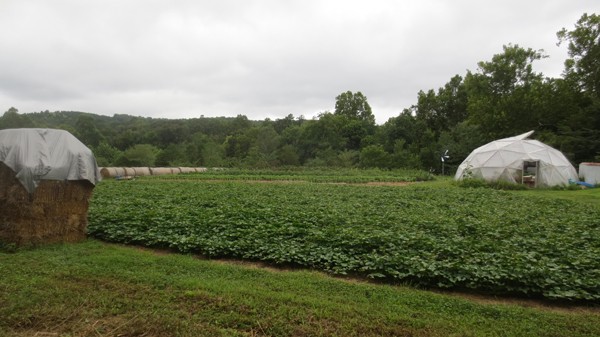
Harvest and storage
The plants will put on the bulk of their tuber weight at the end of the season. Harvest should be completed before or at the first hard frost. Unlike many other root veggies, if the tops freeze, the rot will spread down into the roots. We harvest by hand, along with washing and packing. It takes 4-6 labor hours per 100’ bed, with this harvest procedure:
1) Cut vines with a machete down the middle of the path between beds.
2) Roll vines over to the other side of the bed.
3) Use pruners to cut the vines off the top of each sweet potato clump.
4) Continue to roll vines so they are away from the bed.
5) Using potato forks and/or a broadfork, two people work up each clump and place the tubers on the vine roll.
7) Using a garden hose with good pressure or a spray nozzle, wash off the dirt without taking off the skin.
8) Use pruners or clippers to separate the tubers, and flip the dirty side up.
9) Spray with water again.
10) Let dry, but don’t let them sunburn on a hot, sunny day (30 minutes should be good).
11) We then pack for final sale into 40# sweet potato boxes (ordered from Southern Container).
12) We cure the tubers on pallets in the greenhouse. It takes about 5 days of 85-90 degree temps, or up to 30 days at 70 degrees. Two tubers rubbed against each other shouldn’t take off the skin. At this point they can be moved to long term storage.
Sweet potatoes should be stored at about 60 degrees. Having some ventilation is important, especially in the first few days.
We spread our harvest over about 4 weeks. A time-lapse video of the harvest is available on the Growing for Market Facebook page https://www.facebook.com/GrowingForMarketMagazine/.
We used to keep a cow or two, and they would feast on the sweet potato vines to fatten up for winter. The sheep don’t like the tougher vines, but will eat the leaves and vine tips. One year I used a flail mower to chop the vines up, then packed it in barrels to make silage, but it was not a success. After the harvest we fertilize, compost, and mulch for the winter, planting a bed or two into garlic. A late wave of spinach is another good option.
Below, Theresa follows the diggers, washing the dirt off the tubers with the hose in the foreground. Then she clips the stems off, flips them over, washes the other side and lets them dry in the sun.

The bottom line
I figure it costs us $200/year just to keep a 100’ bed on the farm, and I plan for $600 in sales from a single crop in a bed to be successful. Your numbers may vary. Getting some spring greens harvested from the sweet potato beds beforehand helps pay for that overhead. All in all, costs are about $200 per sweet potato bed, and let’s say $100 of the shared overhead, so a total of $300 in expenses. If we got 500 pounds from a bed and sold them at $.60/lb, we would make no money.
I like to compare sweet potatoes to a lettuce crop, or in this case it would be 3 lettuce crops in the same space and time. We can grow and harvest 400 lettuce heads in a bed, times three, is 1200 lettuce heads, or $2400 wholesale, $3600 at farmers market. If we charge $2.50/lb at farmers market for our 500 lbs of sweet potatoes we get $1,250/bed, pretty good if you can sell a lot of them at market. A good wholesale price for certified organic sweet potatoes of $1.80/lb would gross $900/bed.
On our farm here in rural Arkansas, our family’s success is related to having a workload spread over eleven months of the year. Sweet potatoes allow us to “move” work from the labor-intensive summertime to the fall and winter.
Andrew and Madeleine met seven years ago on Patrice Gros’ Foundation Farm, and have been growing food, children and a homestead since.


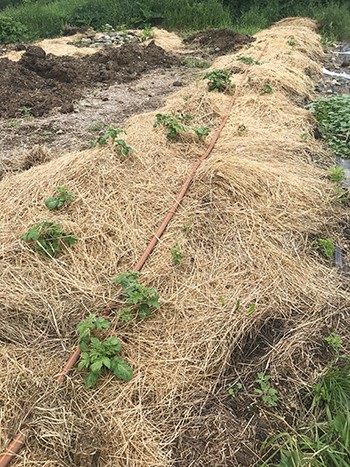 There are good reasons why quick-growing greens crops have gotten a lot of attention in no-till systems. But I wanted to try growing some less common no-till crops, so I grew test plots of potatoes and sweet potatoes on my farm this past year.
There are good reasons why quick-growing greens crops have gotten a lot of attention in no-till systems. But I wanted to try growing some less common no-till crops, so I grew test plots of potatoes and sweet potatoes on my farm this past year.
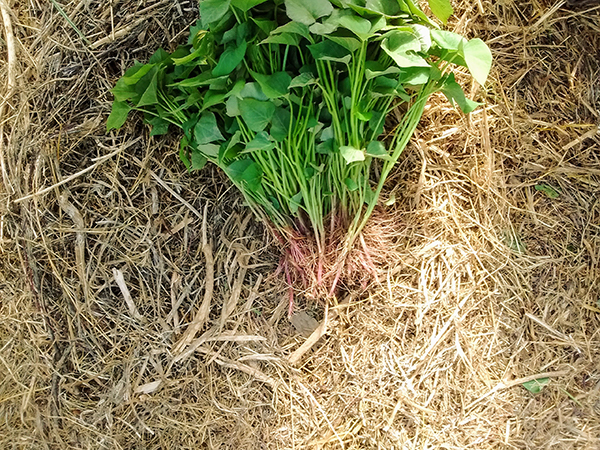 Sweet potatoes are grown from “slips,” pieces of stem with a few leaves from a mother root, not from seeds or replanted roots. We used to buy bare-root slips for transplanting because we didn’t know how to grow our own and had heard it wasn’t easy. We have been growing our own for many years now. We prefer the flexibility and reliability it gives us.
Sweet potatoes are grown from “slips,” pieces of stem with a few leaves from a mother root, not from seeds or replanted roots. We used to buy bare-root slips for transplanting because we didn’t know how to grow our own and had heard it wasn’t easy. We have been growing our own for many years now. We prefer the flexibility and reliability it gives us.
 My wife, Megan, and I grow cut flowers on half an acre of a twelve-acre property in Hurdle Mills, NC. We are in the heart of tobacco country. When we bought our property in 2013, our sales contract stipulated that the farmer had the right to harvest that year’s tobacco crop. Based on our best guesses, that marked at least the 100th consecutive year of tobacco/wheat rotations on this property. The farmer was kind enough to disc in the tobacco stubble after the harvest.
My wife, Megan, and I grow cut flowers on half an acre of a twelve-acre property in Hurdle Mills, NC. We are in the heart of tobacco country. When we bought our property in 2013, our sales contract stipulated that the farmer had the right to harvest that year’s tobacco crop. Based on our best guesses, that marked at least the 100th consecutive year of tobacco/wheat rotations on this property. The farmer was kind enough to disc in the tobacco stubble after the harvest.
 If you’ve been a subscriber to Growing For Market (or even if you haven’t), you’re probably familiar with the many advantages of no-till agriculture. No-till methods can reduce a farm’s carbon footprint, promote complex soil biology, and preserve and build organic matter.
If you’ve been a subscriber to Growing For Market (or even if you haven’t), you’re probably familiar with the many advantages of no-till agriculture. No-till methods can reduce a farm’s carbon footprint, promote complex soil biology, and preserve and build organic matter.
 Julia Asherman appeared on my radar screen a number of years ago because she was a regular presence at the Southern Sustainable Agriculture Working Group conferences where I’ve spoken many times. Colleagues pointed her out to me as a person to watch because she was tough and smart and she was going to make something of herself as a farmer. We became conference buddies. So, when I had the good fortune to get invited to speak at the Georgia Organics Conference in Athens this winter, I knew right away I wanted to take that opportunity to visit Julia at her place, Rag & Frass Farm in Jeffersonville, Georgia.
Julia Asherman appeared on my radar screen a number of years ago because she was a regular presence at the Southern Sustainable Agriculture Working Group conferences where I’ve spoken many times. Colleagues pointed her out to me as a person to watch because she was tough and smart and she was going to make something of herself as a farmer. We became conference buddies. So, when I had the good fortune to get invited to speak at the Georgia Organics Conference in Athens this winter, I knew right away I wanted to take that opportunity to visit Julia at her place, Rag & Frass Farm in Jeffersonville, Georgia.
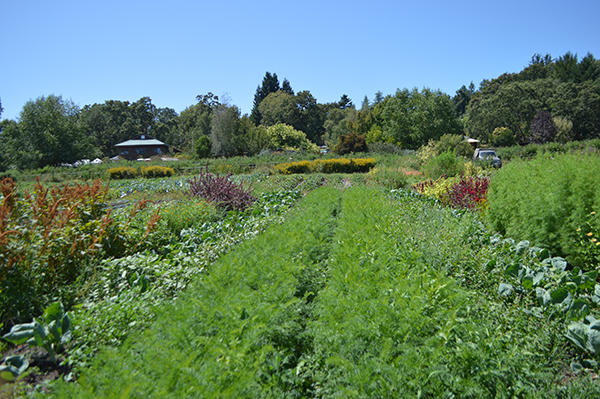 Farmer to Farmer Profile
Farmer to Farmer Profile
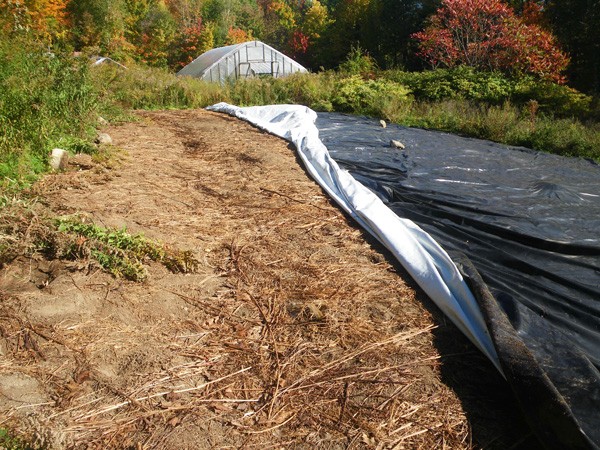 In the mid-1980s I had a farm in upstate New York and grew 20 acres of organic vegetables with machinery. It was organic, but not sustainable both for the use of fossil fuel and high level of personal burnout. I lost my joy of farming and never thought I would go back into it for my livelihood.
In the mid-1980s I had a farm in upstate New York and grew 20 acres of organic vegetables with machinery. It was organic, but not sustainable both for the use of fossil fuel and high level of personal burnout. I lost my joy of farming and never thought I would go back into it for my livelihood.
 In recent years a great deal of interest has been building around the question of how to run a profitable, chemical-free farm without tillage. We all know what tillage does to soil, but the available information about how not to till on a commercial market garden scale has felt impractical or unusable, much of it geared towards home gardeners or mega grain operations in chemical monoculture. There has been, to be sure, very little in the way of guidance on how to approach a profitable, diversified no-till farm.
In recent years a great deal of interest has been building around the question of how to run a profitable, chemical-free farm without tillage. We all know what tillage does to soil, but the available information about how not to till on a commercial market garden scale has felt impractical or unusable, much of it geared towards home gardeners or mega grain operations in chemical monoculture. There has been, to be sure, very little in the way of guidance on how to approach a profitable, diversified no-till farm. 
 The modern age could very well be termed the age of carbon. We have increased the amount of carbon dioxide (CO2) in the atmosphere by more than a third since the Industrial Revolution began. A gas that keeps heat from the sun contained within the earth’s atmosphere, CO2 makes up more than three-quarters of the greenhouse gas emissions in the world. At the same time agriculture is currently experiencing a carbon crisis, with 50-70% of the world’s carbon in farmland soils off-gassed into the atmosphere due to tillage. Carbon is the single most essential element in soil fertility as it aids soil structure development, water retention, nutrient retention, and biological processes.
The modern age could very well be termed the age of carbon. We have increased the amount of carbon dioxide (CO2) in the atmosphere by more than a third since the Industrial Revolution began. A gas that keeps heat from the sun contained within the earth’s atmosphere, CO2 makes up more than three-quarters of the greenhouse gas emissions in the world. At the same time agriculture is currently experiencing a carbon crisis, with 50-70% of the world’s carbon in farmland soils off-gassed into the atmosphere due to tillage. Carbon is the single most essential element in soil fertility as it aids soil structure development, water retention, nutrient retention, and biological processes. 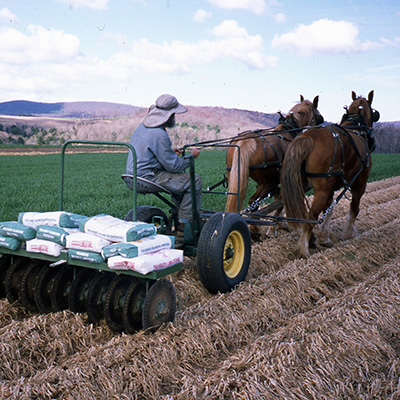
 When we started farming in 1983, there were few models of organic, horse-powered market gardening. So we used the traditional practices for growing field crops here in north-central Pennsylvania, preparing a seedbed with the moldboard plow, spring tooth harrow and cultipacker. We quickly realized we needed to put a whoa on moldboard plowing to dependably establish dryland produce.
When we started farming in 1983, there were few models of organic, horse-powered market gardening. So we used the traditional practices for growing field crops here in north-central Pennsylvania, preparing a seedbed with the moldboard plow, spring tooth harrow and cultipacker. We quickly realized we needed to put a whoa on moldboard plowing to dependably establish dryland produce.